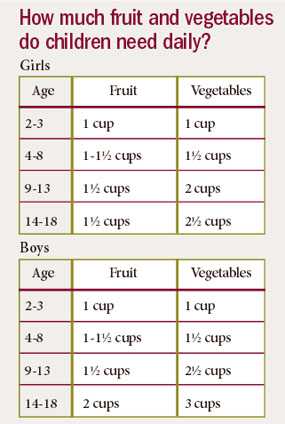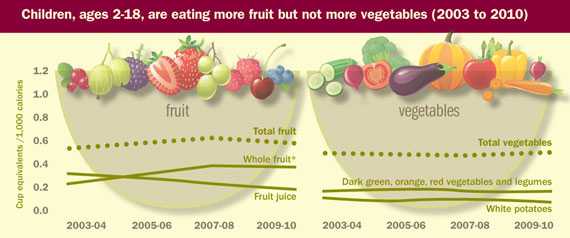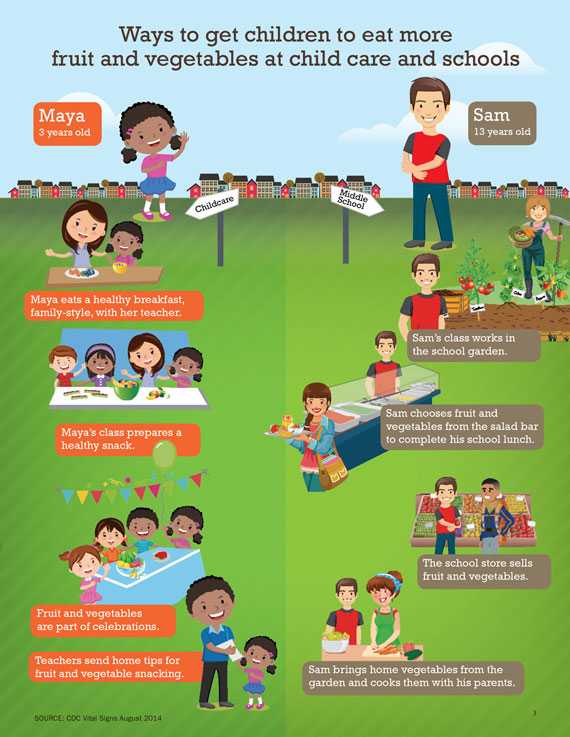Progress on Children Eating More Fruit, Not Vegetables
August 2014


 67%
67%
The amount of whole fruit children ate increased by 67% from 2003 to 2010 but remained low.
 1/3
1/3
The amount of fruit juice children drank decreased by nearly one-third from 2003 to 2010.
 9 in 10
9 in 10
9 in 10 children didn't eat enough vegetables in 2007-2010.
The amount of whole fruit* children, 2-18 years old, ate increased by 67% from 2003 to 2010 and replaced fruit juice as the main contributor of fruit to children's diets. Experts recommend that most fruit come from whole fruit, rather than juice. The amount of vegetables children ate did not change from 2003 to 2010. Moreover, in 2007- 2010, children did not meet recommendations for the amount of fruit and vegetables they should eat.
About 60 million US children are enrolled in child care** or school, where their experiences with food can affect their health and lifelong food choices. Since 2010, new national efforts like Let's Move! and new school nutrition standards support healthy eating.
Child care, schools, and school districts can support these efforts by:
- Meeting or exceeding current federal nutrition standards for meals and snacks.
- Serving fruit and vegetables whenever food is offered.
- Training staff to make fruit and vegetables more appealing and accessible.
- Offering nutrition education and hands-on learning opportunities, such as growing, tasting, and preparing fruit and vegetables.
*Includes all forms of fruit (fresh, frozen, canned, and dried) except juice.
**Includes child care centers, day care homes, Head Start programs, preschool, and pre-kindergarten
Problem
Children aren't Eating Enough Fruit or Vegetables
Children are eating more fruit but not enough.
- 6 in 10 children didn't eat enough fruit in 2007-2010.
- As children get older, they eat less fruit.
Most children need to eat more vegetables.
- 9 in 10 children didn't eat enough vegetables in 2007-2010.
- Children should eat a variety of colorful vegetables prepared in healthy ways.
- About 1/3 of vegetables children ate in 2009-2010 were white potatoes, most (63%) of which were eaten as fried potatoes, such as French fries, or as chips.

These amounts are for children who get less than 30 min/day of moderate physical activity, beyond normal daily activities. More active children may be able to consume more while staying within calorie needs.
SOURCE: USDA, www.ChooseMyPlate.gov
SOURCE: National Health and Nutrition Examination Survey 2003 to 2010
*All forms of fruit excluding juices
Infographic
What Can Be Done
Federal government is
- Funding states and communities to improve healthy eating in child care and schools.
- Offering resources on healthy eating through programs such as ChooseMyPlate.gov, We Can!, HealthierUS School Challenge, and Let's Move!
- Helping low-income families get more fruit and vegetables through programs such as the WIC Cash Value Voucher, Supplemental Nutrition Assistance Program (SNAP), Child and Adult Care Food Program (CACFP), Fresh Fruit and Vegetable Program, and school meal programs such as the National School Lunch and Breakfast Programs.
State and local officials can
- Include nutrition standards that meet or exceed CACFP or those found in Caring for our Children in child care licensing requirements and Quality Rating and Improvement Systems.
- Provide training for child care and school staff on buying, preparing, and serving fruit and vegetables.
- Help child care providers and schools reduce fruit and vegetable purchasing costs and develop farm to school and farm to preschool initiatives.
Child care, schools, and school districts can
- Meet or exceed current federal nutrition standards for meals and snacks.
- Include fruit and vegetables whenever food is offered.
- Train food preparation staff to make fruit and vegetables more appealing and accessible.
- Offer nutrition education and hands-on learning opportunities, such as growing, tasting, and preparing fruit and vegetables.
Parents can
- Eat fruit and vegetables with their children.
- If serving frozen or canned vegetables or fruit, choose those with low or no sodium and no added sugar.
- Provide fruit and vegetables for snacks instead of less healthy options.
- Include their children when shopping for, growing, and preparing fruit and vegetables.
- Encourage children to eat a variety of fruit and vegetables, even if it takes many tries.
- Learn what counts as a cup of fruit or vegetables, for example:
- 1 small apple; 8 large strawberries.
- 12 baby carrots; 1 large ear of corn.
Science Behind the Issue
Related Pages
- Vital Signs Issue details: Vital Signs: Fruit and Vegetable Intake Among Children — United States, 2003–2010, Morbidity and Mortality Weekly Report (MMWR)
- Vital Signs – Progress on children eating more fruit, not vegetables [PODCAST – 1:15 minutes]
- Vital Signs – Progress on children eating more fruit, not vegetables [PSA – 0:60 seconds]
- Winnable Battles: Nutrition, Physical Activity, and Obesity
- The State Indicator Report on Fruits & Vegetables, 2013 [PDF – 4.6 MB]
- CDC Guide to Strategies to Increase the Consumption of Fruits and Vegetables [PDF – 2.1 MB]
- Childhood Obesity Prevention Strategies and Solutions for My Community
- School Health Guidelines to Promote Healthy Eating and Physical Activity
- Childhood Overweight and Obesity
- CDC Fruit and Vegetable Calculator: How Many Fruits and Vegetables Do You Need?
- CDC News Room Digital Press Kit
On Other Web Sites
- MedlinePlus – Child Nutrition
- MedlinePlus – School Health
- USDA Healthier School Day – “Tool for Schools” Toolkit
- Let’s Move!
- Let’s Move! Child Care
- Let’s Move Salad Bars to Schools
- We Can!
- ChooseMyPlate.gov
- USDA Farm to School Program
- Institute of Medicine. Accelerating Progress in Obesity Prevention
- Institute of Medicine. Early Childhood Obesity Prevention Policies
- Page last reviewed: August 5, 2014
- Page last updated: August 5, 2014
- Content source:
- National Center for Chronic Disease Prevention and Health Promotion, Division of Nutrition, Physical Activity, and Obesity
- Page maintained by: Office of the Associate Director for Communications (OADC)


 ShareCompartir
ShareCompartir

